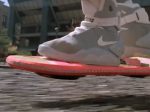It may be a while until we see a working space elevator.
Google X, the search giant's lab responsible for "moonshot" projects like Google Glass, driverless cars, and Project Loon, has unsuccessfully tried to build a space elevator, Fast Company reports.
Google X encountered problems with the space elevator due to material limitations. In order for it to work, Google would need a cable that is "at least a hundred times stronger than the strongest steel we have," Google X employee Dan Piponi told Fast Company.
The team did find one material that could work, carbon nanotubes, but no one has successfully made a perfectly formed carbon nanotube strand longer than a meter. That put the space elevator project in "a deep freeze," but Google is still keeping tabs on advancements in the carbon nanotube field.
Google X also tinkered with the idea of a hoverboard. It considered using magnets to keep the hoverboard aloft, but since magnets tend to shift polarities, the hoverboard would constantly flip over.
The team considered using other materials, but ultimately decided it would be way too expensive, especially for a product that would only mildly affect society and the economy.
The general rule for X projects are that they must address a problem that affects millions of people. All must utilize some radical solution that resembles science fiction, and must tap into technologies that are obtainable.
"When we let it go, it's a positive thing," Google X Rapid Evaluation Team and Design Lead Richard DeVaul told Fast Company. "We're saying, 'This is great: Now we get to work on other things.'"
See Also:
- This Is Why Google Has Two Operating Systems
- Why Google Is Making Massive, Crazy Bets On Drones And Robots
- This Is Google CEO Larry Page's Grand Vision For Changing The World
SEE ALSO: Why Google Is Making Massive, Crazy Bets On Drones And Robots
